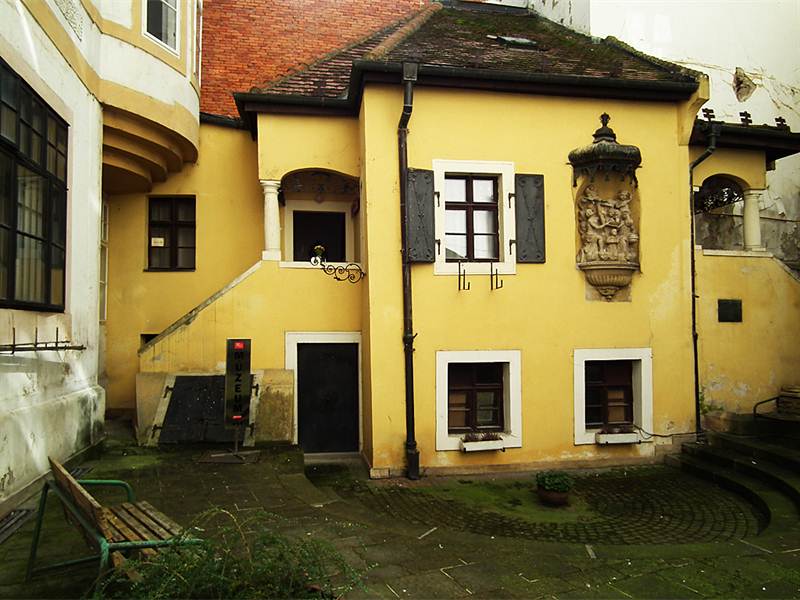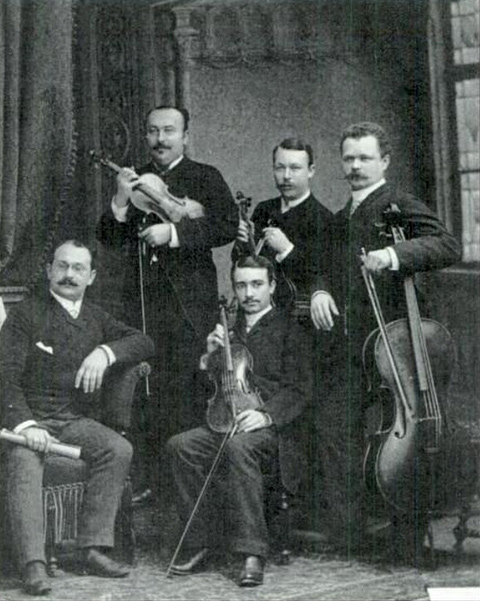|
Piano Quintet (Hummel)
The Piano Quintet in E-flat major, Op.87, is a composition by the Austrian composer Johann Nepomuk Hummel. Composed in 1802, it was not published until around 1822 and might have served as an example cited by Sylvester Paumgartner who commissioned Schubert to write his own piano quintet. Instrumentation The piece is written for a then-common combination of instruments in a piano quintet; namely, the piano is joined by violin, viola, cello and double bass (the double bass is replaced with another violin, much like a string quartet, in later piano quintets). Perhaps, along with Schubert's Trout Quintet, the two are the most famous pieces written for such a combination. Hummel later transcribed his septet A septet is a formation containing exactly seven members. It is commonly associated with musical groups but can be applied to any situation where seven similar or related objects are considered a single unit, such as a seven-line stanza of poetry. ... for this combination of instrume ... [...More Info...] [...Related Items...] OR: [Wikipedia] [Google] [Baidu] |
Johann Nepomuk Hummel
Johann Nepomuk Hummel (14 November 177817 October 1837) was an Austrian composer and virtuoso pianist. His music reflects the Transition from Classical to Romantic music, transition from the Classical period (music), Classical to the Romantic music, Romantic musical era. He was a pupil of Mozart, Salieri and Muzio Clementi, Clementi. He also knew Beethoven and Schubert. Life Early life Hummel was born as an only child (which was unusual for that period) in Pressburg, Kingdom of Hungary (now Bratislava, Slovakia). He was named after the Czech patron saint John of Nepomuk. His father, Johannes Hummel, was the director of the Imperial School of Military Music in Vienna; his mother, Margarethe Sommer Hummel, was the widow of the wigmaker Josef Ludwig. The couple married just four months beforehand. Hummel was a child prodigy. At the age of eight, he was offered music lessons by the classical composer Wolfgang Amadeus Mozart, who was impressed with his ability. Hummel was taught ... [...More Info...] [...Related Items...] OR: [Wikipedia] [Google] [Baidu] |
Schubert
Franz Peter Schubert (; 31 January 179719 November 1828) was an Austrian composer of the late Classical and early Romantic eras. Despite his short lifetime, Schubert left behind a vast ''oeuvre'', including more than 600 secular vocal works (mainly lieder), seven complete symphonies, sacred music, operas, incidental music, and a large body of piano and chamber music. His major works include "Erlkönig" (D. 328), the Piano Quintet in A major, D. 667 (''Trout Quintet''), the Symphony No. 8 in B minor, D. 759 (''Unfinished Symphony''), the "Great" Symphony No. 9 in C major, D. 944, the String Quintet (D. 956), the three last piano sonatas (D. 958–960), the opera ''Fierrabras'' (D. 796), the incidental music to the play ''Rosamunde'' (D. 797), and the song cycles ''Die schöne Müllerin'' (D. 795) and ''Winterreise'' (D. 911). Born in the Himmelpfortgrund suburb of Vienna, Schubert showed uncommon gifts for music from an early age. His father gave him his first violin l ... [...More Info...] [...Related Items...] OR: [Wikipedia] [Google] [Baidu] |
Trout Quintet
The ''Trout Quintet'' (''Forellenquintett'') is the popular name for the Piano Quintet in A major, D. 667, by Franz Schubert. The piano quintet was composed in 1819, when he was 22 years old; it was not published, however, until 1829, a year after his death. Rather than the usual piano quintet lineup of piano and string quartet, the ''Trout Quintet'' is written for piano, violin, viola, cello and double bass. The composer Johann Nepomuk Hummel had rearranged his own Septet for the same instrumentation, and the ''Trout'' was actually written for a group of musicians coming together to play Hummel's work. Nickname The piece is known as the ''Trout'' because the fourth movement is a set of variations on Schubert's earlier Lied "Die Forelle" ("The Trout"). The quintet was written for Sylvester Paumgartner, a wealthy music patron and amateur cellist from Steyr, Upper Austria, who also suggested that Schubert include a set of variations on the Lied. Sets of variations on melodies ... [...More Info...] [...Related Items...] OR: [Wikipedia] [Google] [Baidu] |
Piano Quintet
In classical music, a piano quintet is a work of chamber music written for piano and four other instruments, most commonly a string quartet (i.e., two violins, viola, and cello). The term also refers to the group of musicians that plays a piano quintet. The genre particularly flourished during the nineteenth century. Until the middle of the nineteenth century, most piano quintets were scored for piano, violin, viola, cello, and double bass. Following the success of Robert Schumann's Piano Quintet in E major, Op. 44 in 1842, which paired the piano with a string quartet, composers increasingly adopted Schumann's instrumentation, and it was this form of the piano quintet that dominated during the second half of the nineteenth century and into the twentieth century. Among the best known and most frequently performed piano quintets, aside from Schumann's, are those by Franz Schubert, Johannes Brahms, César Franck, Antonín Dvořák and Dmitri Shostakovich. The piano quintet befo ... [...More Info...] [...Related Items...] OR: [Wikipedia] [Google] [Baidu] |
Piano Quintet
In classical music, a piano quintet is a work of chamber music written for piano and four other instruments, most commonly a string quartet (i.e., two violins, viola, and cello). The term also refers to the group of musicians that plays a piano quintet. The genre particularly flourished during the nineteenth century. Until the middle of the nineteenth century, most piano quintets were scored for piano, violin, viola, cello, and double bass. Following the success of Robert Schumann's Piano Quintet in E major, Op. 44 in 1842, which paired the piano with a string quartet, composers increasingly adopted Schumann's instrumentation, and it was this form of the piano quintet that dominated during the second half of the nineteenth century and into the twentieth century. Among the best known and most frequently performed piano quintets, aside from Schumann's, are those by Franz Schubert, Johannes Brahms, César Franck, Antonín Dvořák and Dmitri Shostakovich. The piano quintet befo ... [...More Info...] [...Related Items...] OR: [Wikipedia] [Google] [Baidu] |
Compositions By Johann Nepomuk Hummel
Composition or Compositions may refer to: Arts and literature * Composition (dance), practice and teaching of choreography *Composition (language), in literature and rhetoric, producing a work in spoken tradition and written discourse, to include visuals and digital space *Composition (music), an original piece of music and its creation * Composition (visual arts), the plan, placement or arrangement of the elements of art in a work * ''Composition'' (Peeters), a 1921 painting by Jozef Peeters * Composition studies, the professional field of writing instruction * ''Compositions'' (album), an album by Anita Baker * Digital compositing, the practice of digitally piecing together a video Computer science * Function composition (computer science), an act or mechanism to combine simple functions to build more complicated ones *Object composition, combining simpler data types into more complex data types, or function calls into calling functions History *Composition of 1867, Austro-Hunga ... [...More Info...] [...Related Items...] OR: [Wikipedia] [Google] [Baidu] |
Compositions For Piano Quintet
Composition or Compositions may refer to: Arts and literature * Composition (dance), practice and teaching of choreography *Composition (language), in literature and rhetoric, producing a work in spoken tradition and written discourse, to include visuals and digital space *Composition (music), an original piece of music and its creation * Composition (visual arts), the plan, placement or arrangement of the elements of art in a work * ''Composition'' (Peeters), a 1921 painting by Jozef Peeters * Composition studies, the professional field of writing instruction * ''Compositions'' (album), an album by Anita Baker * Digital compositing, the practice of digitally piecing together a video Computer science * Function composition (computer science), an act or mechanism to combine simple functions to build more complicated ones *Object composition, combining simpler data types into more complex data types, or function calls into calling functions History * Composition of 1867, Austro-Hung ... [...More Info...] [...Related Items...] OR: [Wikipedia] [Google] [Baidu] |
1802 Compositions
Eighteen or 18 may refer to: * 18 (number), the natural number following 17 and preceding 19 * one of the years 18 BC, AD 18, 1918, 2018 Film, television and entertainment * ''18'' (film), a 1993 Taiwanese experimental film based on the short story ''God's Dice'' * ''Eighteen'' (film), a 2005 Canadian dramatic feature film * 18 (British Board of Film Classification), a film rating in the United Kingdom, also used in Ireland by the Irish Film Classification Office * 18 (''Dragon Ball''), a character in the ''Dragon Ball'' franchise * "Eighteen", a 2006 episode of the animated television series ''12 oz. Mouse'' Music Albums * ''18'' (Moby album), 2002 * ''18'' (Nana Kitade album), 2005 * '' 18...'', 2009 debut album by G.E.M. Songs * "18" (5 Seconds of Summer song), from their 2014 eponymous debut album * "18" (One Direction song), from their 2014 studio album ''Four'' * "18", by Anarbor from their 2013 studio album '' Burnout'' * "I'm Eighteen", by Alice Cooper commonly ... [...More Info...] [...Related Items...] OR: [Wikipedia] [Google] [Baidu] |


